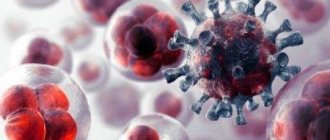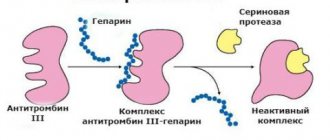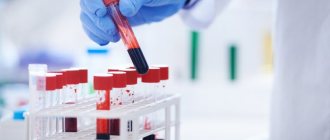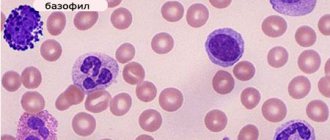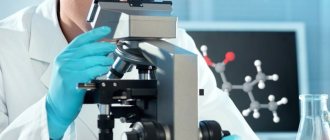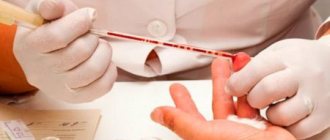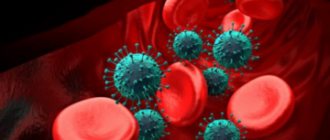What is LDH in the blood?
In order to understand the purpose of the test, you should first understand what LDH is in a biochemical blood test?
Lactate dehydrogenase (LDH) in the blood is an enzyme localized inside cells. The composition necessarily includes zinc ions. The main function is to catalyze the oxidation of lactic acid to pyruvate. Almost all cells in the human body contain the enzyme LDH. The maximum concentration is observed in skeletal (9000 units/g) and cardiac (25,000 units/g) muscles, as well as in the kidneys (15,000 units/g), lungs (9500 units/g) and liver (9000 units/g).
In case of cell damage, the enzyme is actively released into the bloodstream. Blood cells also contain LDH, however, their content is insignificant. That is why, even with slight destruction of the tissues of any organ, there is a sharp increase in the level of LDH in the blood serum, which is used to diagnose various diseases. This fact allows us to classify the blood test for LDH as a highly sensitive, but low-specific criteria.
Enzyme isoforms
From the point of view of the information content of the results obtained, LDH isoforms are more preferable due to an increase in the level of specificity. There are 5 known isoforms of the enzyme with characteristic physicochemical properties.
Isoform
The organ that produces
Reasons for the increase
LDH activity increases with the development of almost any disease accompanied by inflammatory processes and cell death. Among the reasons for the increase in the indicator are the following:
- Myocardial infarction in the acute phase.
- Functional failure of the vascular and cardiac systems, lungs. Malfunctions of the heart lead to circulatory disorders, the appearance of congestive symptoms and activation of LDH fractions 4 and 5.
- Inflammation of the lungs, liver and kidney parenchyma.
- Hemolytic and pernicious anemia.
- , pulmonary embolism.
- Viral hepatitis during exacerbation. While in the chronic form of the pathology, the LDH level does not go beyond normal limits.
- Tumor formations of a malignant nature, especially with metastases, the location of which is the liver.
- Hematological diseases, for example, granulocytosis, anemia, the development of which was preceded by a lack of vitamin B12 or folic acid deficiency.
- Massive platelet destruction. The main reason for this pathological condition is blood transfusions.
- Pathologies of the musculoskeletal system. First of all, this applies to damage to the skeletal muscles (atrophy in the initial stages, various injuries).
Determination of the glycolytic enzyme is very important in the diagnosis of myocardial infarction.
Lactate dehydrogenase may also increase for other reasons. These include:
- megaloblastic anemia;
- conditions in which increased destruction of the cellular structure occurs (acute necrotic processes);
- damage to the kidney parenchyma;
- tumors localized in the glands of the reproductive system of men and women.
Thus, the main reasons for the increase in enzymes in the blood serum are pathologies in which the cells of the kidney and liver parenchyma, as well as erythrocytes and platelets are destroyed.
Indications for the study
A doctor can write out a referral for a biochemical analysis of blood serum to determine the level of LDH if:
- the patient experiences symptoms of chronic or acute damage to the integrity of cells and tissues;
- a person feels severe pain in the chest area, the cause of which may be myocardial infarction or angina pectoris;
- it is necessary to control the course of chronic pathologies, including oncology;
- large-scale screening of human health is carried out.
Indications for analysis
A blood test for lactate dehydrogenase is a biochemical one, and is prescribed if the following diseases are suspected:
- Severe forms of anemia . Such pathological conditions lead to the death of red blood cells due to insufficient iron in the body. This leads to an increase in LDH;
- Suspicions of tumor formations . LDH biochemistry is not a means of diagnosing cancer. To do this, doctors use a tumor marker;
- Death of heart muscle tissue . The LDH compound is released into the blood during necrosis of myocardial tissue;
- All pathological conditions in which any tissue of the human body dies.
Any suspicion of necrotic changes in tissues inside the human body leads to a referral for a biochemical blood test for LDH.
What additional tests are recommended?
In addition to measuring the levels of this enzyme, additional types of blood tests may be prescribed.
These include:
- Alanine aminotransferase (ALT);
- Aspartate aminotransferase (AST);
- Creatine kinase general;
- Creatine kinase MB;
- Lactate dehydrogenase 1, 2 (LDH 1, 2 fractions);
- Total alkaline phosphatase;
- Troponin I;
- Myoglobin.
Myoglobin
Preparing for analysis
Once a patient has been scheduled for LDH testing, some preparatory measures should be taken. They are followed in order to obtain the most accurate result, since some third-party factors can affect the composition of the blood.
The actions that must be taken when preparing for LDH analysis are:
- The analysis is given on an empty stomach. Eating must be stopped at least eight hours before donating blood;
- At least one day before blood sampling , you need to stop eating fatty, highly salted, spicy or spicy foods;
- At least 7 days (!) give up alcoholic beverages;
- Strong physical activity;
- If the patient is taking medications (vitamin C), they must be stopped at least 48 hours before blood sampling. If you continuously use drugs, you need to notify your doctor about this so that he takes into account all the amendments in the test results, which will contribute to an accurate diagnosis;
- Avoid stressful situations , nervous breakdowns and anything that burdens the nervous system.
If you do not follow the measures recommended above, this may lead to inaccurate test results, as a result of which you will have to donate blood again.
Norm of LDH in the blood
Any interpretation of the results should be carried out exclusively by a specialist. Due to the low specificity of the criterion under consideration, its isolated use for the final diagnosis of the disease is prohibited. Indicators of normal LDH concentrations in adults and children in the blood are shown in the table.
Floor
Normal values, U/l
It should be noted that normal LDH levels are higher in men than in women. Deviation from the reference (normal) values to a greater or lesser extent indicates the development of a pathological process.
The value of LDH isoenzyme indicators
The activity of isoenzymes is determined by the degree of inactivation by urea. It has been established that the level of inhibition of the enzymatic activity of human serum by urea ranges from 26 to 36%. This indicator is considered as a standard value for comparing the inhibitory properties of the five isoenzyme fractions.
Isoenzyme
Inactivation level of total urea activity, %
The table shows that each fraction has its own level of inhibition. Based on the known data on the priority organ of synthesis of each isoenzyme, and the obtained test results, it is possible with a high degree of probability to determine the organ in which the disease develops.
Prevention
In order for the LDH level to be within normal limits, it is recommended to follow preventive actions aimed at counteracting the progression of many diseases:
- Proper nutrition. A balanced diet is necessary, excluding unhealthy foods, highly fried, salty, and spicy foods. Eat more fresh vegetables and fruits, as well as lean meats and foods rich in vitamins and nutrients;
- A healthy lifestyle is an integral factor in the prevention of most diseases. It is recommended to exercise to maintain body tone, as well as to avoid excess weight and increased cholesterol deposits;
- Avoiding stress . Limit yourself as much as possible from nervous tension, stressful influences and strong emotional stress. All of them have a detrimental effect on overall health;
- Take medications regularly if prescribed by your doctor. Failure to comply with the course of therapy can lead to tissue death in the body and death;
- Stay hydrated. Drink at least one and a half liters of clean water per day;
- Stop drinking alcohol and cigarettes;
- Once a year, be examined by a doctor, take a blood test and fully examine your body. This will help detect diseases at an early stage of development, which will greatly facilitate the course of therapy and the possibility of complications.
This list of actions is aimed at preventing a large number of diseases and will help minimize the chance of damage to the body.
Reasons for increased LDH in a biochemical blood test
The criterion under consideration may deviate from normal values in a number of different diseases. The reasons for the increase in lactate dehydrogenase concentration may be:
- myocardial infarction, accompanied by ischemic necrosis of the middle layer of muscle tissue of the heart;
- blockage of a pulmonary artery with a blood clot or pulmonary infarction;
- blood pathologies, which are characterized by the destruction of red blood cells (various types of anemia, hemolysis, severe intoxication);
- malignant tumors affecting various organs and tissues, often accompanied by metastasis;
- disturbances in liver function due to chronic and acute hepatitis, Gospel disease or alcohol intoxication;
- kidney pathologies (glomerular nephritis, pyelonephritis);
- muscle tissue atrophy or injury;
- open and closed fractures;
- congestive heart or coronary failure;
- inflammation of heart muscle tissue;
- mononucleosis, viral etiology;
- acute attack of pancreatitis;
- seizures;
- alcoholic delirium (mental abnormalities due to sudden withdrawal of alcohol);
- burn disease;
- premature placental abruption;
- hyperfunction of the thyroid gland.
When identifying the causes of increased LDH in women and men, it is necessary to exclude the influence of factors that can lead to unreliable results:
- improper blood sampling, resulting in the destruction of red blood cells in the test tube (hemolysis);
- neglect of the rules of preparation for the delivery of biomaterial: physical and emotional stress, smoking, alcohol, poor diet;
- the use of treatment methods accompanied by electrical stimulation of the patient a week before the analysis;
- excess platelets in the blood;
- taking medications that activate the enzyme system.
Causes of increased lactate dehydrogenase (LDH) enzyme
Lactate dehydrogenase (LDH) is an enzyme that is involved in the oxidation of glucose and the formation of lactic acid. In the body of a healthy person, LDH does not accumulate, but is destroyed and eliminated naturally. However, there are a number of diseases and pathological conditions that are characterized by a moderate or significant increase in LDH in the blood.
- 1 What is LDH?
- 2 Normal
- 3 Level Up
- 4 Level down
What is LDH?
LDH is found in almost every organ, but the highest concentrations are present in the liver, skeletal muscle and myocardium. The enzyme has five isoenzymes (modifications), which differ from each other in structure, as well as in their specificity - each of them is concentrated in a specific organ.
- LDH-1 predominates in the tissues of the heart muscle and brain;
- LDH-1 and LDH-2 are found in blood cells (erythrocytes, platelets) and kidneys;
- LDH-3 is an enzyme in skeletal muscle, lungs, thyroid and pancreas, adrenal glands and spleen;
- LDH-4 is found in the same tissues as LDH-3, as well as in the liver, placenta, male germ cells and granulocytes;
- LDH-5 is characteristic of the liver and skeletal muscles, as well as organs containing LDH-4.
Due to the fact that the concentration of LDH in the blood increases in diseases that are accompanied by damage to tissues and cells, this enzyme is a very important diagnostic marker.
An analysis that determines the concentration of LDH in the blood, in combination with other tests, is often used to identify a variety of disorders in the body.
Such a study is prescribed to determine the following diseases and pathologies:
- Diagnosis of myocardial infarction, heart and lung diseases with complaints of severe chest pain;
- Diagnostics of malignant neoplasms;
- Diagnosis of muscle pathologies;
- Monitoring the treatment of cancer patients and the course of certain diseases;
- Comprehensive examination of patients.
Norm
The level of LDH in the body of a healthy person depends primarily on his age: thus, at the beginning of life, its concentration increases, and over the years it begins to decrease. Reference values:
Age LDH concentration, in µkat/l
| Newborns on the first day of life | up to 22.1 |
| Newborns from 2nd to 5th day of life | up to 28.9 |
| Children from the 6th day of life to 6 months | up to 16.3 |
| Children from 6 months to one year | up to 18.3 |
| Children from 1 year to 3 years | up to 14.2 |
| Boys from 7 to 12 years old | up to 12.7 |
| Girls from 7 to 12 years old | up to 9.67 |
| Boys over 13 years old and adult men | up to 11.4 |
| Girls over 13 years old and adult women | up to 7.27 |
Level up
The level of LDH may be elevated in the patient’s blood with the following diseases and pathological conditions:
- Myocardial infarction: an increase in the concentration of LDH in the blood during myocardial infarction is observed in the first 36-55 hours, after which the enzyme level persists for 3-10 days
- Congestive heart failure
- Pulmonary infarction: an increase in lactate dehydrogenase is observed already in the first day after the onset of pain in the chest area
- Kidney pathologies (kidney infarction, pyelonephritis, etc.)
- Liver diseases: acute viral hepatitis, cirrhosis, changes in liver tissue due to alcoholism
- Oncological diseases: testicular cancer, liver, kidney tumors, etc.
- Intestinal infarction
- Stroke
- Leukemia
- Blood diseases that are accompanied by hemolysis (hemolytic, megaloblastic, pernicious anemia, erythremia)
- Lymphoma
- Acute pancreatitis
- Infectious mononucleosis
- Conditions accompanied by hypoxia, hypo- and hyperthermia
- Muscle pathologies: dystrophy, atrophy, injuries
- Bone fractures
- Acute pancreatitis
- Multiple burns
- Traumatic shock
- Delirium tremens
- Seizures
- Eclampsia
- During pregnancy, an increase in LDH may be normal or indicate placental abruption
The following factors may affect the test result (physiological or false increase in LDH):
- Heavy physical activity prior to testing
- Alcohol consumption
- The patient has a prosthetic heart valve, which can cause hemolysis of red blood cells
- Use of electropulse therapy on the eve of the study
- Application of hemodialysis
- Some skin diseases
- Thrombocytosis
- Taking medications that can increase LDH levels: acetylsalicylic and valproic acid, anesthetics, anabolic steroids, codeine, nonspecific anti-inflammatory drugs, sulfonamides, penicillin, insulin, caffeine.
The result of a blood test for LDH should be considered only in conjunction with other studies, and treatment depends on the diagnostic results. LDH dynamics plays a very important role in determining the pathological process.
During myocardial infarction, the peak concentration of the enzyme is observed on days 3-4, and remains at the same level for 10 days. In addition, in this case, the patient experiences a significant increase in LDH-1 levels. If a person has suffered not a heart attack, but an attack of angina, the analysis will show the absence of destruction of heart cells.
//www.youtube.com/watch?v=RuA0uXdZJfQ
The main difference between a pulmonary embolism and a heart attack is that in the first case, an increase in LDH is accompanied by an increase in bilirubin levels and normal AST levels.
With inflammation of the membranes of the brain (viral meningitis), an increase in LDH is negative and indicates the development of encephalitis.
With serious liver pathologies, the concentration of LDH increases and remains unchanged for a long time.
When diagnosing any disease, it is very important to determine the activity of a particular isoenzyme in order to determine the localization of the pathological process.
In particular, in patients with acute leukemia, an increase in the activity of LDH-2 and LDH-3 is observed, and in liver diseases, the concentration of LDH-4 and LDH-5 increases.
Malignant neoplasms are characterized by a significant increase in the concentration of isoenzymes LDH-3, LDH-4 and LDH-5.
The level of LDH in the blood of cancer patients decreases with effective therapy, so this marker is used to monitor the dynamics of treatment.
Downgrade
A decrease in LDH levels is typical for the following conditions:
- Increased levels of urea (uremia) and oxalates in the patient's body
- Taking certain medications: ascorbic acid, dofibrate, amikacin, naltrexone, anticonvulsants, etc.
- Specific reaction to cystotic chemotherapy.
To determine the concentration of LDH, blood is donated on an empty stomach from a vein, and the serum must be fresh, without traces of hemolysis, which can give a false positive result.
Source: //med-analyzes.ru/analizy-krovi/biohimiya/fermenty/ldg.html
Normalization of LDH levels in the blood
Patients often wonder how to reduce enzyme levels? To do this, it is necessary to initially establish the exact cause of the increase in LDH. Only by eliminating the disease that was the cause is it possible to return the indicator to normal values. Therapy for each pathology has its own characteristics:
- after the first signs of myocardial infarction, a person needs to provide first aid. Any delay in treatment can lead to death and serious complications. In order to assess the risk of relapse, a control measurement of LDH levels is carried out, which should return to normal with adequate therapy;
- in case of anemia caused by iron deficiency, the patient’s diet is corrected and iron-containing medications are prescribed. A favorable outcome is considered to be an increase in hemoglobin levels and a decrease in LDH;
- in oncopathology, large-scale screening of the patient is necessary to assess the size of the tumor, the presence of metastases and the degree of organ damage. In this case, assessment of the effectiveness of treatment includes analysis of LDH and main tumor markers. The absence of positive dynamics, expressed in a decrease in the criteria under consideration, is a reason to transfer the patient to more aggressive methods of treatment;
- in case of acute pancreatitis, it is necessary to place the patient in a 24-hour hospital. Treatment includes drips with painkillers, antibacterial and anti-inflammatory drugs. As the patient's condition improves, all biochemical parameters return to normal.
Read also
All about the prevention of serious heart pathology - myocardial infarction
LDH is low in the blood or lactate dehydrogenase is low: causes and what it means
If the LDH result is low in the blood, there are two types of reasons. This phenomenon occurs extremely rarely, only in people with active breakdown of glucose in the body, which saturates its cells with energy.
When a person with a low LDH result has muscle weakness, then we should talk about the presence of changes in genes associated with the acceleration of the breakdown of glucose.
Also, a downward deviation in LDH levels, observed in the absence of symptoms, indicates a second type of mutation occurring at the gene level.
The role of LDH in the body and the forms of this substance
To find out the causes of some diseases, you need to conduct a thorough diagnosis with many tests. One of them is to determine the level of LDH in the blood. This detectable enzyme is called lactate dehydrogenase.
With the participation of this enzyme, oxidative processes of glucose occur, as well as the production of lactic acid. LDH does not accumulate in the body; it is broken down and excreted naturally during human life.
Lactate dehydrogenase is involved in glycolysis, the production of energy from glucose to support cell life. All this happens with the help of oxygen, then glucose is broken down into water, energy and carbon dioxide.
When oxygen does not enter the cell, almost 20 times less energy is produced, and lactic acid is formed. LDH is involved in the oxidation of lactic acid, the end product of glucose metabolism. Such glycolysis processes in cancer cells occur in an oxygen-free environment.
LDH may decrease or increase - this indicates disorders in the human body. This enzyme serves as a diagnostic marker that helps determine the causes of pathological changes in tissues. When the level of this enzyme increases, this result will indicate damage to the cells of the human body.
There are several forms of lactate dehydrogenase, they are called isoenzymes, and also differ in their structure and location in different organs:
- Isoenzyme 1 is found in the brain and muscle tissue of the heart.
- Isoenzyme 2 predominates in liver and red blood cells.
- Isoenzyme 3 is located in the endocrine glands, lungs, spleen, skeletal muscles and adrenal glands.
- Isoenzyme 4 is found in the cells where isoenzyme 3 is located, as well as in the liver, placenta, blood granulocytes, and male genitals.
- Isoenzyme 5 is also located in organs containing isoenzyme 4, but can be observed in human skeletal muscle.
In the case of an increase in one of the forms of lactate dehydrogenase, which serves as an informative test, in an acute process requiring urgent treatment, you can find out its activity and content in the body tissues.
When examining the test result, it is necessary to take into account not only the patient’s health status, but also his age.
The younger the patient is, the higher the rate of this enzyme:
- Immediately after the baby is born, his blood will contain 22.1 µkat/l.
- Then the first few days of life the indicator will be more than 28 µkat/l.
- By 6 months of age, the concentration of LDH in the child’s blood will decrease to 16.3 µkat/l.
- At 3 years of age, the level of this substance will be 14.2 µkat/l.
- Until the age of seven, LDH values in children will be the same, then in girls the indicator will become slightly higher (9.6 µkat/l). For boys, the norm will be more than 12.5 µkat/l.
- In a 13-year-old teenager, the level of this substance will be the same as in an adult male - 11.4 µkat/l.
- For teenage girls and women, the value of this substance will be 7.27 µkat/l.
An increase and decrease in these results, as mentioned above, indicates possible pathologies in the body.
In order to find out what disorders a person has, you should undergo a full examination. The attending physician will determine which diagnostic methods will be used for this.
How is LDH analysis performed?
To assess the level of LDH and its enzymatic activity, 2 groups of methods are used:
- spectrophotometric, the essence of which is to determine the difference in the absorption spectra of the oxidized form of NAD (a coenzyme of all living cells) from the reduced one;
- colorimetric, subdivided into dinitrophenylhydrazine - determination of pyruvate concentration, and redox indicator - identification of certain molecules using indicators that change color.
An optical test is used as standards for determining the enzymatic activity of LDH, and electrophoresis is used for isoenzymes. When issuing analysis results, the laboratory must indicate the chosen method.
How to prepare for research
Preparation for the test is necessary to obtain the most reliable and accurate results. The biological material is venous blood collected from the cubital vein on the elbow. Recommendations before analysis:
- blood is donated strictly on an empty stomach; fatty and fried foods must be excluded from the diet for 1 day;
- It is strictly forbidden to drink juice, tea and coffee 12 hours before collecting biomaterial; clean water without gas is allowed;
- do not smoke for 30 minutes;
- Avoid drinking alcohol and taking medications for at least 48 hours. If it is impossible to discontinue any medications, notify the laboratory employee about their use;
- limit physical and emotional stress in 1 hour.
Where and how is it determined in the blood
Different organs are represented by different types of LDH. Thanks to this, doctors can classify enzymes based on their cellular structure. This makes it possible to quickly understand in which organ tissue destruction occurs.
The biological material for this study is blood from a vein. If you want the results of the analysis to be as accurate as possible, you need to prepare for it in advance.
Before analysis, you need to follow some recommendations:
- You must donate blood on an empty stomach; you can have your last meal 8 hours before going to the hospital, and this food should not contain fatty foods or foods containing a large amount of protein.
- 12 hours before the study, it is advisable to give up caffeine-containing drinks, juices, strong tea, and only drink non-carbonated water.
- Smoking is prohibited one hour before the examination.
- You should not take alcoholic beverages or medications 2 days before the test. If you cannot stop taking the medication, you should definitely notify the doctor or nurse who will do the test.
- A few hours before the test, you need to limit physical activity and avoid stress.
All of the above can distort the results of the analysis, which will lead to an erroneous diagnosis, and accordingly, the treatment will be incorrect.
This test is colloquially referred to as a lactate test (ldh). To detect and study LDH in a biochemical blood test, doctors use two different methods. Using a spectrophotometric method, the difference in the difference in absorption of the oxidized and reduced forms of the enzyme is determined. The colorimetric research method reveals the amount of pyruvate, which is released in the body during the breakdown of glucose along with water and carbon dioxide, and with the help of color-changing indicators the presence and amount of the ldh enzyme is detected.
Also during the procedure, an optical test and electrophoresis can be used. The results issued by the laboratory must indicate the method by which the analysis was carried out.
Adults donate blood in the usual way from a vein, while children and infants donate blood using a lancet. A small amount of collected material is then placed either in a regular test tube or on a special glass. The enzyme level is determined using a centrifuge installed in the laboratory. After processing the blood, it produces serum, which is used to determine the total amount of LDH.
conclusions
To summarize, it is necessary to emphasize:
- LDH in a biochemical blood test is a low-specific criterion that allows one to predict a number of diseases. To clarify the diagnosis, additional laboratory and instrumental examinations are required;
- when deciphering the results, it is important to take into account that the reference value is different for a child and an adult;
- in case of necrosis and infarction, which are characterized by cell destruction, it is recommended to repeat the analysis after the acute stage. This is necessary to assess the degree of tissue destruction and the severity of pathology;
- identifying the degree of activity of enzyme isoforms allows us to clarify the location of the pathology.
Yulia Martynovich (Peshkova)
Certified specialist, in 2014 she graduated with honors from the Orenburg State University with a degree in microbiologist. Graduate of the graduate school of the Federal State Budgetary Educational Institution of Higher Education Orenburg State Agrarian University.
In 2020 At the Institute of Cellular and Intracellular Symbiosis of the Ural Branch of the Russian Academy of Sciences, she completed advanced training in the additional professional program “Bacteriology”.
Laureate of the All-Russian competition for the best scientific work in the “Biological Sciences” category 2020.
Lactate dehydrogenase (LDH) in the blood: what is it, the norm in the analysis, reasons for the increase
Laboratory blood tests are informative methods of primary diagnosis. Based on their results, possible disturbances in the functioning of organs and systems of the body are assessed. The study of LDH in biochemical blood analysis is primarily aimed at identifying hematological, cardiac, muscle and oncological pathologies.
LDH (lactate dehydrogenase) is an oxidoreductase enzyme that accelerates the reaction of lactic acid formation during glycolysis (glucose oxidation). Like most catalysts, lactate dehydrogenase does not accumulate in cells, but is excreted from the body in an amount equivalent to that formed.
The highest concentration of the enzyme is observed in the parenchyma of the liver and kidneys, in the tissues of the muscular system and heart. Each localization area has its own isoenzyme (a type of LDH). Lactate dehydrogenase is found in small amounts in red blood cells (erythrocytes).
| Synonyms | ||
| LDH-1 | HHHH, H4 | Heart, kidneys, red blood cells |
| LDG-2 | HHHM, H3M | Spleen, lymph nodes |
| LDG-3 | HHMM, H2M2 | Lungs |
| LDG-4 | HMMM, HM3 | Placenta, pancreas |
| LDG-5 | MMMM, M4 | Skeletal muscles, liver |
| Age | ||
| Both | 0-1 year | Up to 451 |
| 1-3 years | Up to 344 | |
| 3-6 years | Up to 314 | |
| 6-12 years | Up to 332 | |
| 12-18 years old | Up to 271 | |
| Women | 18 and older | 130 — 215 |
| Men | 130 — 230 | |
| LDH-1 | 20-30 | |
| LDG-2 | 25-40 | |
| LDG-3 | 15-25 | |
| LDG-4 | 8-15 | |
| LDG-5 | 8-12 |
| Isoenzyme number | Location | Percentage concentration in blood |
| № 1 | muscle layer of the heart (myocardium), brain tissue | 17–27 |
| № 2 | blood cells (platelet and erythrocyte), renal parenchyma | 27–37 |
| № 3 | lungs, spleen, thyroid gland, adrenal glands, lymphocytes, pancreas | 18–25 |
| № 4 | granular leukocytes, placenta, spleen, adrenal glands, male reproductive cells, lungs, thyroid and pancreas | 3–8 |
| № 5 | hepatocytes (liver cells), bone tissue | up to 5 |
Increased activity of one or another type of lactate dehydrogenase is a marker of the destructive transformation of the tissue of the organs in which it is contained. In a standard biochemical analysis, the form usually indicates the total LDH indicator.
If necessary, an extended study is carried out, assessing each individual isoform of the enzyme (Sevel-Tovarek test, urea inactivation and thermal inhibition methods). In the blood of a healthy person, LDH is static and has certain reference values.
Important! The changed concentration of lactate dehydrogenase does not diagnose a specific disease. The obtained values are compared with other indicators of biochemical analysis. Unsatisfactory results are grounds for additional examination of a particular system or organ.
Blood biochemistry is prescribed:
- according to symptomatic complaints of the patient;
- during a routine check (dispensary examination, screening of pregnant women, IVK, etc.);
- to control the therapy;
- in preparation for surgical interventions.
Increased attention to LDH indicators in a blood test is paid in case of a presumptive diagnosis:
- anemia (anemia);
- ischemic necrosis of part of the myocardium (infarction);
- cirrhosis, hepatitis, liver carcinoma (cancer);
- oncohematological diseases (cancer tumors of the blood and lymphoid tissue);
- blood poisoning (sepsis);
- severe intoxication accompanied by the destruction of red blood cells (hemolysis of red blood cells);
- necrotic processes, and mechanical damage to internal organs.
The biochemical composition of the blood is checked after a course of chemotherapy drugs. For differentiated diagnosis of some bacterial and viral infections, the level of LDH is determined by analyzing the cerebrospinal fluid (cerebrospinal fluid).
Blood analysis
To obtain objective results, blood should be donated on an empty stomach. The fasting regime should be from 8 to 10 hours. On the eve of the analysis it is recommended:
- limit sports (other physical) activities;
- eliminate fatty foods (sausages, mayonnaise sauces, pork, lamb, etc.) and fried foods from the diet;
- exclude alcohol-containing drinks;
- give up coffee;
- stop taking anticoagulants, hormone-containing drugs, ascorbic acid.
Venous blood is collected in the morning in a laboratory setting
Blood for analysis is taken from a vein. Decoding is carried out by comparing the obtained indicators with reference values. The results of the study can be viewed within 24 hours. If an emergency laboratory assessment of LDH levels is necessary (acute conditions), the blood is examined without prior preparation.
The normal level of LDH in the blood of children and adolescents is determined by age. In adults (after 17 years), normative values are graded according to the patient’s gender. The standard measurement of lactate dehydrogenase in laboratory microscopy is U/L.
Reference values for enzyme concentrations for children and adolescents (in Udl)
| Newborn | Baby up to one year old | Up to 3 years | Up to 6 years old | Up to 12 years | Up to 17 years old |
| 2000 | lt; 451 | lt; 344 | lt; 314 | lt; 332 | lt; 280 |
In women, the level of LDH in the blood is lower than in men, which is due to less intense physical activity. Women's standard values range from 135 to 214 U/l, men's - from 135 to 225 U/l. A slight excess of reference values is observed in professional athletes and pregnant women.
Deviation of enzyme activity values in the direction of increasing or decreasing indicators is the basis for advanced diagnostics (laboratory tests and hardware examination of the patient).
Reasons for deviations
In most cases, an unsatisfactory result of a biochemical blood test for LDH means an increase in the concentration of the enzyme.
Read also
Methods of treatment and prevention of rosacea
This is explained by the fact that when there is a destructive violation of the integrity of the cellular structure of an organ, a significant part of lactate dehydrogenase enters the bloodstream.
An extremely reduced level of the enzyme or its complete absence is observed in the decompensated stage of liver cancer and cirrhosis.
Elevated LDH is one of the main clinical diagnostic indicators of myocardial infarction.
The enzyme reaches its maximum activity in the first 24 hours from the onset of a heart attack and remains in increased concentration for 1–2 weeks.
In this case, the duration and degree of activity reflect the scale of necrotic damage to the heart muscle (values can increase tens of times).
To obtain an accurate picture, the ratio of the total content of lactate dehydrogenase to the amount of isoenzyme No. 1, otherwise hydroxybutyrate dehydrogenase (HBDH), is estimated.
In acute cases, GBDG is always elevated, since the total amount of enzyme is reduced in relation to the high concentration of isoenzyme No. 1.
Myocardial infarction is accompanied by an increase in LDH levels
ALT and AST in blood tests
- Blockage of the lumen of the pulmonary artery by a blood clot that has budded from the main thrombus located in a large vein (pulmonary embolism).
- Malignant neoplasms of various locations (liver, kidneys, etc.), and secondary tumor foci (metastases).
- Oncohematology.
- Anemia (anemia) of various origins associated with hemolysis of red blood cells. Hemolytic anemia is associated with poisoning of the body with heavy metals or with incorrectly performed blood transfusion (blood transfusion). Addison-Birmer disease or pernicious anemia develops due to a lack of cyanocobalamin (vitamin B12) in the body.
- Liver diseases associated with the death of hepatocytes.
- Destructive and degenerative processes in muscle fibers, muscle atrophy, traumatic damage to muscle tissue.
- Inflammation of the tubular system of the renal apparatus, damage to the glomeruli (glomeruli of the kidneys), otherwise glomerulonephritis, necrosis of the kidney.
- Viral infection of the lymph nodes, pharynx, liver, spleen (mononucleosis).
- Acute inflammation of the pancreas (pancreatitis).
- Termination of functionality (death) of pancreatic cells (pancreatic necrosis).
- Death of the intestinal wall due to insufficient blood supply (intestinal infarction).
- Bone fractures.
- Pathology of the thyroid gland, in which the synthesis of hormones is reduced (hypothyroidism).
- Acute symptomatic seizure;
- Metal-alcohol psychosis (“delirium tremens”).
- Severe gestosis (pathological toxicosis in the second half of pregnancy).
- Extensive skin burns.
- Infectious-toxic pneumonia (Pneumocystis pneumonia).
- Early separation of the provisional organ from the walls of the uterus (premature placental abruption).
- Violation of coronary blood flow (coronary insufficiency);
- Heart disease in the decompensated stage.
- Necrotic lesion of a part of a living organism (gangrene).
Chemotherapy causes a natural increase in LDH. The aggressive treatment method kills not only pathological cells, but also destroys some healthy ones.
The condition of low lactate dehydrogenase levels is much less common. First of all, incorrect therapy with ascorbic acid preparations, anticonvulsant and antitumor medications, antibiotics, and hormonal medications is assumed.
The reasons for the decrease in enzyme levels may be a violation of pH (acidity) due to the presence of oxalic acid salts (oxalates), or genetic abnormalities. If the values drop, the patient’s medications are discontinued (except for vital ones).
Important! LDH levels in the blood can change not only due to cell destruction, but also for non-pathological reasons.
Factors that distort the results include:
- non-compliance with the rules of preparation for blood sampling for LDH;
- intense sports training;
- physical or psycho-emotional overload on the eve of analysis;
- thrombocytosis - an abnormal increase in blood platelets (platelets) in the blood;
- acute and chronic skin diseases;
- extrarenal blood purification by hemodialysis;
- perinatal period in women.
The medical reason for unreliable results may be incorrect blood sampling and examination of biomaterial
Additionally
To reduce the level of the enzyme, it is first necessary to diagnose the underlying disease that caused the change in LDH concentration. Auxiliary diagnostics include:
- laboratory blood test to determine the content of enzymes:
- hepatic and cardiac - ALT and AST (alanine aminotransferase and aspartate aminotransferase);
- muscle - CPK (creatine phosphokinase);
- ALP (alkaline phosphatase).
- blood test for the globular protein troponin and the oxygen-binding protein myoglobin.
- advanced analysis to determine the concentration of all isoenzymes.
Analysis for LDH (lactate dehydrogenase): normal in the blood, elevated - reasons
The LDH (lactate dehydrogenase) test is a non-specific test that is used when a number of diseases and conditions are suspected.
The enzyme enters the blood plasma during the destruction of almost any cell in the body, including bacterial ones. Therefore, the level of LDH in the blood is a general indicator of tissue and cellular damage.
Sometimes the concentration of a substance is assessed using cerebrospinal or pulmonary fluid in the presence of certain diseases.
The importance of the enzyme in the body
Interest in what LDH is in a biochemical blood test is associated primarily with myocardial infarction. Previously, this test was used to diagnose and monitor damage to cardiac tissue, but now the troponin test is considered more accurate and informative.
Lactate dehydrogenase (LDH) is not a specific indicator of cardiac cell damage and is no longer used in patients with suspected acute coronary syndrome. Typically, the transcript of a biochemical blood test contains this indicator.
Lactate dehydrogenase in the blood is an important enzyme involved in the reactions:
The peculiarity of the enzyme is that it does not accumulate in cells, but is completely broken down and excreted. LDH is essential for converting glucose into energy for the functioning of all cells in the body.
The reaction is mediated by oxygen, which helps break down glucose into water, carbon dioxide and energy. Without oxygen, energy production decreases by 20 times and lactic acid accumulates. The enzyme LDH is necessary for its oxidation and return to glucose metabolism.
Unlike healthy cells, cancerous tumors feed without oxygen.
When is the test prescribed?
The test is used when acute and chronic tissue damage is suspected, as well as to evaluate progressive diseases. In rare cases, the test can help identify target organ damage.
The enzyme is determined in a venous blood sample. After injury, LDH is elevated, rises for 48 hours and reaches a maximum after 2-3 days, then gradually decreases. The normal level is restored within 10 days.
Research shows that the LDH blood chemistry test is an indicator of cancer development and progression. Even after taking into account the factor of age and stage of the disease in patients, a strong association with the risk of death remained. This relationship was true for all types of malignant tumors.
The blood LDH test can be used to detect and evaluate:
acute or chronic tissue damage;
progression of anemia and severe infection;
course of cancer after chemotherapy for lymphoma, leukemia, melanoma, neuroblastoma. High values indicate poor prognosis for patient survival.
- The doctor prescribes determination of LDH levels in other body fluids:
- To distinguish between bacterial and viral meningitis by analyzing cerebrospinal fluid.
- To identify the cause of the accumulation of fluid in the chest or abdomen (pleural, peritoneal and pericardial fluids) due to trauma and inflammation or due to an imbalance of pressure within the blood vessels and the amount of protein in the blood.
Recommendations before analysis
- Doctors advise following the following recommendations regarding the study:
- A blood test for LDH (biochemistry) is taken on an empty stomach from a vein.
- The last meal 8 hours before the examination should not contain too much fatty or protein foods.
- It is recommended to give up alcohol and smoking the day before (at least an hour before the test).
Be sure to inform if you need to take medications regularly. Aspirin, hormonal contraceptives and antidepressants affect clotting and may show elevated values.
Intense training the day before can lead to an increase in the enzyme, as it increases energy expenditure and the need for the breakdown of glucose.
Many factors influence the results of the analysis, and they are not always a cause for concern and further examination:
Hemolysis of blood samples leads to false-positive results. Violation of the rules for storing samples and rough processing affect the accuracy.
With increased platelet count, serum LDH level also increases and does not show the real picture.
During hospitalization with suspected myocardial infarction and acute pancreatitis, LDH analysis is performed without taking into account the recommendations. Often, the LDH indicator is used to assess the dynamics of the disease and the patient’s recovery.
Norm of LDH in the body and interpretation of the analysis
When testing blood, the norm is usually indicated in units/l, which means one per liter. The interpretation of the analysis takes into account the age and gender of the patient. A relatively small amount of the enzyme is found in the blood of a healthy adult. In a child under two years of age, the norm is considered to be within 430 units/l.
| The first days of life LDH is normal | at level 150-785 |
| first six months | 160-437 |
| from 7 to 12 months | 145-365 |
| from 1 year to two years | 86-305 |
| from 3 to 16 years | 100-290 units/l |
| in children under 12 years of age | not higher than 295 units/l |
| in men | 120-214 units/l |
| LDH levels are higher in women | 135-240 |
An increase in lactate dehydrogenase occurs during pregnancy, in newborns, and in professional athletes.
Based on the identified marker, it is impossible to determine which cells were damaged. Therefore, when deciphering LDH, it is necessary to know what its isoenzymes are. Some laboratories conduct additional tests that determine several forms of the substance, starting with the most mobile:
- the first indicates a problem with the heart, kidneys and red blood cells;
- the second is found mainly in cardiomyocytes and erythrocytes;
- the third is found in lung tissue, endocrine glands and adrenal glands;
- the fourth is an enzyme in white blood cells, liver, placenta and male testicles and muscle tissue;
- the fifth is found in all organs containing LDH-4, as well as skeletal muscles.
- Deciphering biochemistry for increased LDH in the blood is now considered less informative.
High values of all isoenzymes determine the pathology of several organs. Myocardial infarction with congestive heart failure causes lung damage and liver congestion.
In cancer and autoimmune diseases such as lupus, lactate dehydrogenase is generally elevated. Hypoxia, shock and burns are accompanied by cell death, which shows an increase in LDH.
Caffeine also affects the amount of enzyme in the blood.
The dynamics of the first isoenzyme are more sensitive and specific than the increase in LDH in general. Usually the level of the second isoenzyme is higher than the first. If the concentration of LDH-1 increases relative to LDH-2, a heart attack is diagnosed.
Typically, the LDH level in the blood is exceeded 12-24 hours after damage to heart tissue and for two days in 80% of cases. A normal LDH-1/LDH-2 ratio is reliable evidence that there was no attack.
The ratio of total LDH to LDH-1 is called hydroxybutyrate dehydrogenase. Therefore, during a heart attack:
the LDH/GBDG figure is reduced (less than 1.30);
the LDH-1/LDG-2 ratio approaches 1 and sometimes exceeds this value.
On the first day, myocardial infarction is diagnosed by the creatine kinase indicator, and a day later - by the enzymatic study of LDH. The activity of the substance is directly related to the area of damage to the heart muscle.
- Other serious diseases are reflected in the ratio of isoenzymes and coefficients:
- hemolytic anemia is characterized by a low LDH/GBDG figure - up to 1.3 and below;
- in megaloblastic anemia, LDH-1 significantly exceeds LDH-2;
- the general level increases during acute necrotic processes and cell death, such as damage to the kidney parenchyma;
- tumors in the gonads (ovaries and testes) are accompanied by an isolated increase in LDH-1.
Most often, LDH is elevated due to the destruction of tissue of the liver and kidney parenchyma, and the death of platelets and red blood cells.
LDH in a blood test is considered in relation to other indicators:
With anemia, red blood cells are destroyed, which releases large amounts of LDH into the blood. The disease is diagnosed against the background of low hemoglobin. Weakness, pallor, shortness of breath may be indications for examination.
Blood cancer is associated with the production of abnormal blood cells, which is reflected in the levels of many indicators: LDH, aspartate aminotransferase, bilirubin, urea. At the same time, there is a decrease in the level of glucose and the blood clotting factor fibrinogen. A biochemical blood test allows one to suspect pathology and refer the patient to identify tumor markers.
Along with the LDH level in the blood, which indicates the death of pancreatic cells, bilirubin and glucose will increase. The primary indicator is the level of the pancreatic enzyme amylase.
Reasons for the increase
Elevated LDH levels can be caused by various diseases:
- stroke;
- some types of anemia (pernicious and hemolytic)
- kidney and liver diseases;
- muscular dystrophy;
- pancreatitis;
- Infectious mononucleosis;
- some forms of cancer.
The concentration of the enzyme increases after the administration of anesthetics and aspirin, as well as after intense physical exercise. Normal and decreased LDH levels are not pathological. A factor that reduces the indicator is the consumption of a large dose of ascorbic acid (vitamin C).
- The reasons that lactate dehydrogenase is elevated are varied: HIV infection, sepsis, acute kidney disease, infarction of the intestines and lungs, bone fractures, rash on the body.
- LDH is low when transudate accumulates in body cavities, such as the abdomen, usually caused by congestive heart failure or cirrhosis.
Basic concepts and functions of LDH
LDH (lactate dehydrogenase) is an oxidoreductase enzyme that accelerates the reaction of lactic acid formation during glycolysis (glucose oxidation). Like most catalysts, lactate dehydrogenase does not accumulate in cells, but is excreted from the body in an amount equivalent to that formed.
The highest concentration of the enzyme is observed in the parenchyma of the liver and kidneys, in the tissues of the muscular system and heart. Each localization area has its own isoenzyme (a type of LDH). Lactate dehydrogenase is found in small amounts in red blood cells (erythrocytes).
An increase in the level of the enzyme in the blood occurs during the destruction of LDH-containing cells. By assessing the type of elevated isoenzyme during biochemistry, the location of the damage is determined, that is, the organ whose cells have undergone destruction. The enzyme isoforms are numbered 1 to 5, depending on their location:
| Isoenzyme number | Location | Percentage concentration in blood |
| № 1 | muscle layer of the heart (myocardium), brain tissue | 17–27 |
| № 2 | blood cells (platelet and erythrocyte), renal parenchyma | 27–37 |
| № 3 | lungs, spleen, thyroid gland, adrenal glands, lymphocytes, pancreas | 18–25 |
| № 4 | granular leukocytes, placenta, spleen, adrenal glands, male reproductive cells, lungs, thyroid and pancreas | 3–8 |
| № 5 | hepatocytes (liver cells), bone tissue | up to 5 |
Increased activity of one or another type of lactate dehydrogenase is a marker of the destructive transformation of the tissue of the organs in which it is contained. In a standard biochemical analysis, the form usually indicates the total LDH indicator.
If necessary, an extended study is carried out, assessing each individual isoform of the enzyme (Sevel-Tovarek test, urea inactivation and thermal inhibition methods). In the blood of a healthy person, LDH is static and has certain reference values.
Classification
LDH can be divided into isoenzymes that have differences in composition or are found in one specific organ.
Lactate dehydrogenase is classified into several types depending on the organs in which it is present:
- LDH-1 - in the brain and heart;
- 2 - in the blood composition (platelets and erythrocytes) and liver;
- 3 - in skeletal muscles, lungs, pancreas and thyroid glands, adrenal glands and spleen;
- 4 and 5 - in the same organs that are named in the previous paragraph, plus in the liver, placenta, male germ cells, granulocytes.
Depending on the type of LDH, the activity of the enzyme in the blood may differ slightly.
Indications for research
Blood biochemistry is prescribed:
- according to symptomatic complaints of the patient;
- during a routine check (dispensary examination, screening of pregnant women, IVK, etc.);
- to control the therapy;
- in preparation for surgical interventions.
Increased attention to LDH indicators in a blood test is paid in case of a presumptive diagnosis:
- anemia (anemia);
- ischemic necrosis of part of the myocardium (infarction);
- cirrhosis, hepatitis, liver carcinoma (cancer);
- oncohematological diseases (cancer tumors of the blood and lymphoid tissue);
- blood poisoning (sepsis);
- severe intoxication accompanied by the destruction of red blood cells (hemolysis of red blood cells);
- necrotic processes, and mechanical damage to internal organs.
The biochemical composition of the blood is checked after a course of chemotherapy drugs. For differentiated diagnosis of some bacterial and viral infections, the level of LDH is determined by analyzing the cerebrospinal fluid (cerebrospinal fluid).
Blood analysis
To obtain objective results, blood should be donated on an empty stomach. The fasting regime should be from 8 to 10 hours. On the eve of the analysis it is recommended:
- limit sports (other physical) activities;
- eliminate fatty foods (sausages, mayonnaise sauces, pork, lamb, etc.) and fried foods from the diet;
- exclude alcohol-containing drinks;
- give up coffee;
- stop taking anticoagulants, hormone-containing drugs, ascorbic acid.
Read also
Diagnosis, treatment and prevention of ICP abnormalities
Blood for analysis is taken from a vein. Decoding is carried out by comparing the obtained indicators with reference values. The results of the study can be viewed within 24 hours. If an emergency laboratory assessment of LDH levels is necessary (acute conditions), the blood is examined without prior preparation.
Determination of LDH level
The blood is tested for LDH content using a special technique called the “UV test”. Blood is taken from a vein in the morning (before 10) and on an empty stomach. The resulting substance is then centrifuged to separate the serum from the plasma. It is very important that the serum is clean, without traces of red blood cell breakdown, otherwise the result may be incorrect. Attention! It is not advisable to smoke or drink alcohol on the eve of the test. In addition, you should not eat 6-8 hours before the test, and you should limit your intake of protein and fatty foods. Intense sports can also distort the results. The final indicator is also influenced by the medications taken, so it is worth postponing taking medications on the day of the study. Usually, the results of the analysis can be seen already on the 2nd day of the examination.
Important! An increase in LDH levels does not always indicate pathology. There are physiological reasons for an increase in enzyme levels, such as pregnancy, infancy or increased physical activity.
When LDH is elevated
An increase in LDH concentration occurs in the following pathologies:
- stroke
- myocardial, intestinal or lung infarction
- pulmonary failure
- hypoxia
- acute pancreatitis
- pancreatic diseases
- low blood pressure
- diseases that affect the hepatobiliary complex
- cancer of the blood, kidneys, testicles, etc.
- cirrhosis of the liver
- jaundice (in the first stages of the disease)
- iron deficiency or pernicious anemia
- eclampsia
- placental abruption
- some fungal diseases
- lymphoma
- hepatitis
- Infectious mononucleosis
- skeletal muscle injuries, traumatic shock
- dystrophic condition
- glomerulonephritis
- leukemia
- oxygen deficiency
To accurately determine where the pathological process occurs, it is necessary to analyze which LDH isoenzyme is elevated.
An increase in LDH-1 or LDH-2 levels most often indicates a heart attack. If the concentration of LDH-1 and LDH-3 is increased, then it can be assumed that the patient is developing muscle tissue atrophy. Excessive activity of LDH-4 and 5 isoenzymes often indicates liver dysfunction, as well as muscle and bone damage. If cancer is suspected, then the greatest attention is paid to the amount of LDH-3, 4 and 5.
Important! Elevated LDH levels can be found in conditions such as:
- alcohol consumption
- psychological stress or increased physical activity
- certain skin diseases
- use of certain medications (most often aspirin, anesthetics, fluorides, oral contraceptives and insulin)
- thrombocytosis
When LDH is low
A decrease in the concentration of lactate dehydrogenase in the blood is typical in the following situations:
- consumption of large amounts of ascorbic acid;
- high levels of oxalic acid salts (oxalates) in urine
- a peculiar reaction to cystotic chemotherapy.
A decrease in LDH is very rare and is not always interpreted as evidence of the presence of disorders in the body.
Standard values
The normal level of LDH in the blood of children and adolescents is determined by age. In adults (after 17 years), normative values are graded according to the patient’s gender. The standard measurement of lactate dehydrogenase in laboratory microscopy is U/L.
Reference values for enzyme concentrations for children and adolescents (in Udl)
| Newborn | Baby up to one year old | Up to 3 years | Up to 6 years old | Up to 12 years | Up to 17 years old |
| 2000 | Important! LDH levels in the blood can change not only due to cell destruction, but also for non-pathological reasons. Non-pathological changes in indicatorsFactors that distort the results include:
|
LDH values
It is impossible to make a diagnosis based on changes in LDH concentration in the blood. Only a doctor can interpret and draw any conclusions. The normal concentration of LDH in the blood depends on the age, gender and condition of the patient. Doctors use the following reference values in their work:
- From the birth of a child to the first year, this parameter is equal to 451 units per liter
- From the first to the third year of life, this value is 344 units per liter
- From 3 to 6 years the norm will correspond to 314 units per liter
- At 6-12 years old the norm is 332 units per liter
- From 12 to 17 years the norm will be in the range of 279 units per liter
- At 17 years of age and older, the reference value of the norm is already distributed depending on the gender of the person being studied. For male patients these values will be 135-225 units per liter. For females - 135-214 units per liter
For pregnant women and professional athletes, the reference values of LDH are higher than in the population.
Additionally
To reduce the level of the enzyme, it is first necessary to diagnose the underlying disease that caused the change in LDH concentration. Auxiliary diagnostics include:
- laboratory blood test to determine the content of enzymes:
- hepatic and cardiac - ALT and AST (alanine aminotransferase and aspartate aminotransferase);
- muscle - CPK (creatine phosphokinase);
- ALP (alkaline phosphatase).
- blood test for the globular protein troponin and the oxygen-binding protein myoglobin.
- advanced analysis to determine the concentration of all isoenzymes.
With a comparative assessment of all indicators, a hardware examination of internal organs is prescribed (ultrasound, MRI, CT and other procedures, depending on the expected location of the disorders).
Results
Lactate dehydrogenase is an enzyme that catalyzes the oxidation of glucose and the formation of lactic acid. The main amount of LDH is concentrated in the kidney, liver, cardiac tissues and muscle fibers. A specific isoenzyme (a type of LDH) is responsible for each organ.
Standard values for blood levels in adults
from 135 to 214 U/lot 135 to 225 U/lChildren's indicators are graded by age category. If a biochemical analysis determines increased activity of lactate dehydrogenase in the blood, it means that the integrity of the parenchyma of the liver, kidneys, and myocardium (heart muscle) is compromised. In case of destructive damage to the listed organs, the enzyme is released into the systemic bloodstream through the affected areas.
High rates are clinical signs of heart attack, cirrhosis, cancerous tumors, pancreatic necrosis, pulmonary thromboembolism, renal diseases and other pathologies associated with tissue destruction and death of cellular structures. Based on the results of the study, a specific disease is not diagnosed. A shift in indicators is the basis for an extensive examination of the patient.
All about reduced lactate dehydrogenase
Lactate dehydrogenase or LDH plays an important role in the life of the body and measuring its level is necessary for diagnosing many diseases.
This enzyme is found in cells and tissues of the entire body. Therefore, by its content in the blood it is impossible to accurately identify the disease, but only to suspect a pathological process.
Cases where lactate dehydrogenase is low are rare and require additional research.
LDH is found in almost all cells and tissues of the human body and is involved in important chemical reactions. The enzyme plays an important role in the process of glucose oxidation with the release of energy to maintain cell life.
This reaction can occur either in the presence of oxygen or without it. The result is carbon dioxide, water molecules and energy. LDH is also directly involved in the synthesis of lactic acid. When there is insufficient oxygen in the body, the level of lactic acid increases sharply.
In this case, LDH promotes its conversion to pyruvic acid.
LDH is not able to accumulate in the human body.
It breaks down very quickly and is eliminated naturally .
Watch a video about this enzyme
How is the analysis carried out?
To identify low or high levels of the enzyme, patients are prescribed a biochemical blood test. Venous blood is used as the test material. Typically, blood is drawn from the crook of the arm. In some cases, material may be taken from the heel or earlobe. Blood is drawn from babies using a special lancet.
The puncture site is first cleaned with special antiseptic solutions. Then a puncture is made with a sterile syringe and needle. The resulting material is collected in a sterile tube. In a laboratory setting, it is placed in a centrifuge to obtain serum.
And only after that the research begins.
What can affect the result of the analysis?
The accuracy of the results largely depends on the correctness of blood sampling , patient preparation and the correctness of the analysis. It is necessary to donate blood only on an empty stomach in the morning.
The day before the test, it is necessary to avoid taking fatty, fried and spicy foods, alcohol and medications. If the patient takes medications on an ongoing basis, then the specialist must be informed about this, since some drugs can increase indicators.
The day before, it is important to avoid any physical activity and nervous tension.
Also, the result of the analysis can be affected by irregularities in the process of blood sampling, long-term storage of biomaterial and errors of the laboratory assistant during the analysis process.
What values are considered low?
If LDH is reduced in the blood, this means that pathological changes are occurring in the body . The normative indicator directly depends on the patient’s age. Low LDH levels in patients are quite rare. A similar phenomenon occurs as a result of accelerated breakdown of glucose. Low indicators are considered:
- newborns less than 180 units/l;
- in babies under 12 months below 138 units/l;
- in children under 15 years of age, the lower limit is 98 units/l;
- in adult women and men – 123 units/l.
Lactate dehydrogenase can be reduced by various human gene mutations .
Symptoms and signs
In most cases, when LDH levels are low, a person does not experience symptoms. Some gene mutations may cause
- weakness,
- drowsiness,
- weight loss,
- lethargy and apathy.
Dangers and Consequences
Any pathological process entails certain consequences for a person. That is why timely diagnosis and treatment play an important role.
In most cases, low enzyme values do not indicate the development of any pathology.
Causes
Since low enzyme levels are very rare, there are few reasons for this phenomenon:
- long-term use of ascorbic acid, cefotaxime, metronidazole and other medications;
- high content of urea and oxalates in the human body (occurs when stones form in the urinary tract and kidneys);
- gene mutations;
- in the treatment of cancer, lymphoma, anemia, leukemia.
To normalize the level of the enzyme, therapy is used aimed at eliminating the main cause of the pathological process.
It must be remembered that only a qualified specialist should prescribe drug and non-drug treatment, based on the research results and the patient’s condition.
For cancer patients, antitumor drugs are prescribed in combination with chemotherapy, immunomodulatory drugs and a specialized diet that will provide the body with all the beneficial vitamins and minerals.
During the diagnostic process, the patient may need additional consultation with a geneticist, hematologist or oncologist.
To select the appropriate treatment, the patient must undergo all prescribed tests and instrumental studies without fail.
Discontinuation of drugs that caused a decrease
Some medications can significantly reduce LDH levels in the blood. To normalize the level, you must stop taking medications or replace them with similar ones, but only after agreement with your doctor. If use is mandatory, then it is important to monitor blood counts during the course of treatment.
Prevention
To prevent the development of pathological processes in the body, every person must carefully monitor their health. A set of preventive measures includes eliminating bad habits, maintaining a healthy lifestyle, following a specialized diet, a moderately active lifestyle and timely contact with specialists at the first unpleasant symptoms.
Low LDH is less common than high LDH.
But biochemical analysis plays an important role in diagnosing the condition of the body . Therefore, you should not neglect your doctor’s recommendations and monitor your health.
Source: https://1pokrovi.ru/analizy-krovi/bioximicheskij/fermenty/ldg/ponizhennaya-laktatdegidrogenaza.html
